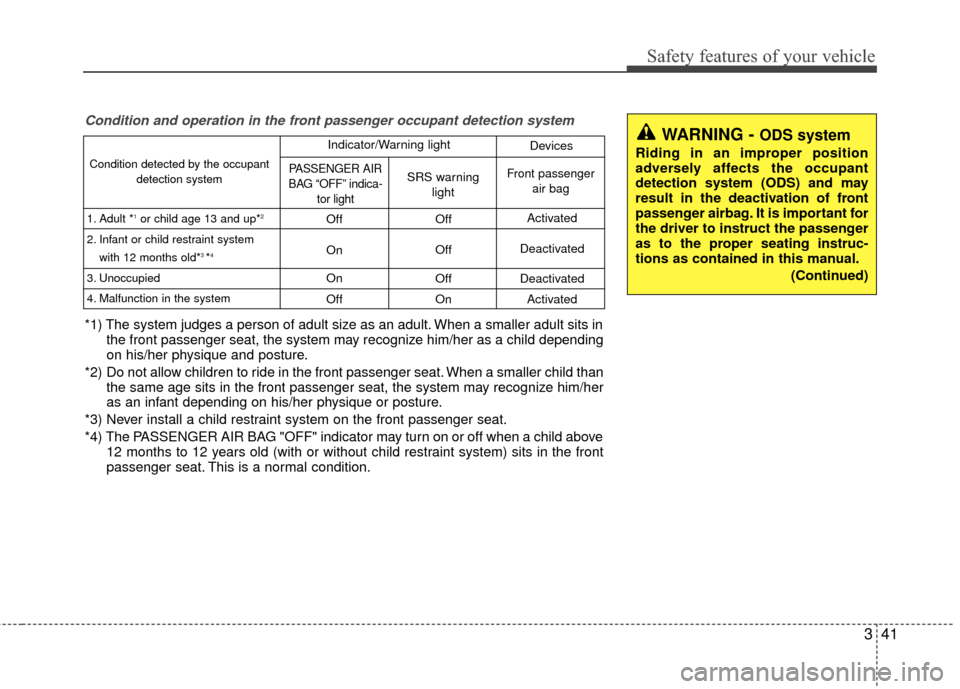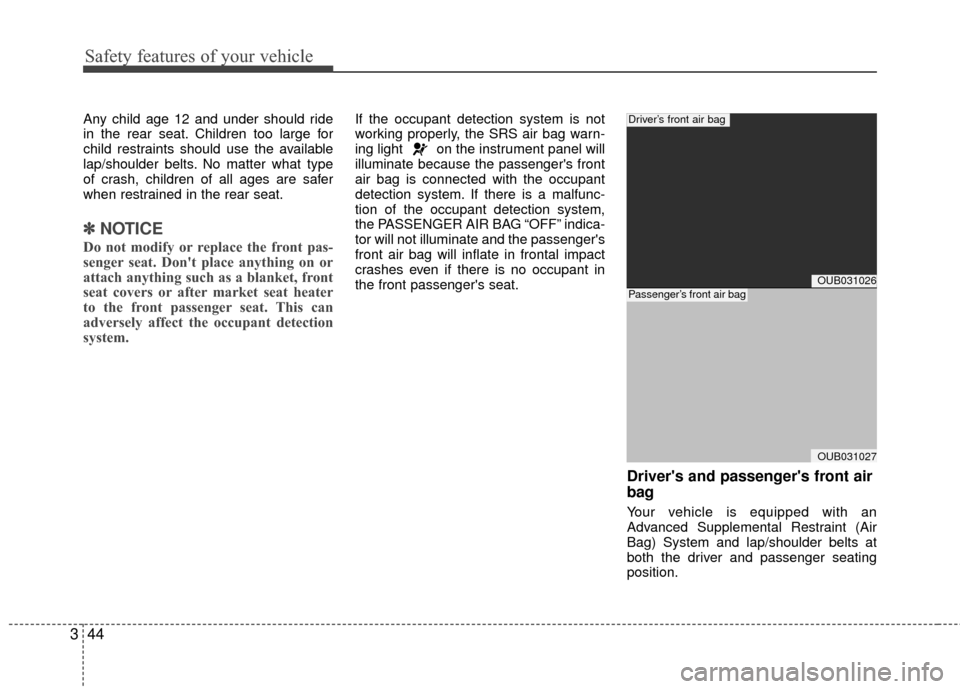2016 KIA Rio child restraint
[x] Cancel search: child restraintPage 56 of 449

341
Safety features of your vehicle
WARNING - ODS system
Riding in an improper position
adversely affects the occupant
detection system (ODS) and may
result in the deactivation of front
passenger airbag. It is important for
the driver to instruct the passenger
as to the proper seating instruc-
tions as contained in this manual.(Continued)
Condition and operation in the front passenger occupant detection system
*1) The system judges a person of adult size as an adult. When a smaller adult sits inthe front passenger seat, the system may recognize him/her as a child depending
on his/her physique and posture.
*2) Do not allow children to ride in the front passenger seat. When a smaller child than the same age sits in the front passenger seat, the system may recognize him/her
as an infant depending on his/her physique or posture.
*3) Never install a child restraint system on the front passenger seat.
*4) The PASSENGER AIR BAG "OFF" indicator may turn on or off when a child above 12 months to 12 years old (with or without child restraint system) sits in the front
passenger seat. This is a normal condition.
Condition detected by the occupant
detection system
1. Adult *
1or child age 13 and up*2
2. Infant or child restraint system with 12 months old*3 *4
3. Unoccupied
4. Malfunction in the system
Off
On
On
Off Off
Off
Off
On Activated
Deactivated
Deactivated Activated
PASSENGER AIR
BAG “OFF” indica- tor lightSRS warninglightFront passenger air bag
Indicator/Warning light Devices
Page 59 of 449

Safety features of your vehicle
44
3
Any child age 12 and under should ride
in the rear seat. Children too large for
child restraints should use the available
lap/shoulder belts. No matter what type
of crash, children of all ages are safer
when restrained in the rear seat.
✽ ✽
NOTICE
Do not modify or replace the front pas-
senger seat. Don't place anything on or
attach anything such as a blanket, front
seat covers or after market seat heater
to the front passenger seat. This can
adversely affect the occupant detection
system.
If the occupant detection system is not
working properly, the SRS air bag warn-
ing light on the instrument panel will
illuminate because the passenger's front
air bag is connected with the occupant
detection system. If there is a malfunc-
tion of the occupant detection system,
the PASSENGER AIR BAG “OFF” indica-
tor will not illuminate and the passenger's
front air bag will inflate in frontal impact
crashes even if there is no occupant in
the front passenger's seat.
Driver's and passenger's front air
bag
Your vehicle is equipped with an
Advanced Supplemental Restraint (Air
Bag) System and lap/shoulder belts at
both the driver and passenger seating
position.
OUB031026
OUB031027
Driver’s front air bag
Passenger’s front air bag
Page 60 of 449

345
Safety features of your vehicle
The indications of the system's presence
are the letters "AIR BAG" embossed on
the air bag pad cover in the steering
wheel and the passenger's side front
panel pad above the glove box.
The SRS consists of air bags installed
under the pad covers in the center of the
steering wheel and the passenger's side
front panel above the glove box.
The purpose of the SRS is to provide the
vehicle's driver and/or the front passen-
ger with additional protection than that
offered by the seat belt system alone in
case of a frontal impact of sufficient
severity. The SRS uses sensors to gather
information about the driver's seat posi-
tion, the driver's and front passenger's
seat belt usage and impact severity.The advanced SRS offers the ability to
control the air bag inflation with two lev-
els. A first stage level is provided for mod-
erate-severity impacts. A second stage
level is provided for more severe impacts.
The passenger’s front air bag is designed
to help reduce the injury of children sit-
ting close to the instrument panel in low
speed collisions. However, children are
safer if they are restraint in the rear seat.
According to the impact severity, seating
position and seat belt usage, the SRSCM
(SRS Control Module) controls the air
bag inflation. Failure to properly wear
seat belts can increase the risk or sever-
ity of injury in an accident.
Additionally, your vehicle is equipped
with an occupant detection system in the
front passenger's seat. The occupant
detection system detects the presence of
a passenger in the front passenger's seat
and will turn off the front passenger's air
bag under certain conditions. For more
detail, see "Occupant detection system"
in this section.
Do not place any objects that may cause
magnetic fields near the front seat. These
may cause a malfunction of the seat
track position sensor.
Page 443 of 449

I3
Index
Brake system··················\
··················\
··················\
············5-22Anti-Lock Brake System (ABS) ··················\
··············5-25
Electronic Stability Control (ESC)··················\
············5-27
Good braking practices··················\
··················\
············5-32
Hill-start Assist Control (HAC)··················\
·················5-30\
Parking brake ··················\
··················\
··················\
·········5-24
Power brakes··················\
··················\
··················\
··········5-22
Vehicle Stability Management (VSM) ··················\
······5-30
BRAKE/CLUTCH fluid ··················\
··················\
···········7-39 Checking the brake/clutch fluid level··················\
········7-39
Bulb wattage ··················\
··················\
··················\
··············8-3
Child restraint system ··················\
··················\
················3-25 Using a child restraint system ··················\
··················\
·3-26
Climate control air filter ··················\
··················\
············7-42 Filter inspection ··················\
··················\
··················\
·····7-42
Cruise Control system ··················\
··················\
···············5-34 To cancel cruise control:············\
··················\
················5-37
To decrease the cruising speed: ··················\
·················5-36\
To increase cruise control set speed: ··················\
·········5-35
To resume cruising speed at more than approximately40 km/h (25 mph):··················\
··················\
·················5-37\
To set cruise control speed: ··················\
··················\
·····5-34
To temporarily accelerate with the cruise control on: ··5-36
To turn cruise control off:··················\
··················\
········5-38 Defroster ··················\
··················\
··················\
··················\
4-83
Rear window defroster ··················\
··················\
············4-83
Dimensions ··················\
··················\
··················\
················8-2
Door locks··················\
··················\
··················\
················4-16 Auto door Lock/Unlock feature ··················\
················4-18
Child-protector rear door lock ··················\
··················\
·4-19
Impact sensing door unlock system ··················\
··········4-18
Operating door locks from inside the vehicle ·············4-17
Operating door locks from outside the vehicle ··········4-16
Economical operation ··················\
··················\
················5-44
Emergency starting ··················\
··················\
··················\
····6-5 Jump starting ··················\
··················\
··················\
···········6-5
Push-starting ··················\
··················\
··················\
··········6-7
Emission control system ··················\
··················\
············7-92 1. Crankcase emission control system ··················\
······7-92
2. Evaporative emission control (including ORVR:Onboard Refueling Vapor Recovery) system ············7-92
3. Exhaust emission control system ··················\
··········7-93
Engine ··················\
··················\
··················\
··················\
······8-2
Engine compartment ··················\
··················\
············2-6, 7-2
Engine coolant ··················\
··················\
··················\
·········7-36 Changing the coolant ··················\
··················\
···············7-38
Checking the coolant level ··················\
··················\
·····7-36D
CE